 Written by Heather Collins, MSN, RN, CNOR
Written by Heather Collins, MSN, RN, CNOR
Supplemental oxygen therapy is a medical treatment that effectively helps people with COPD, emphysema, COVID-19, and other breathing issues to receive the necessary amount of oxygen to function and stay healthy. Hypoxemia, characterized by low levels of oxygen in the blood, can result in organ failure and be life-threatening if left untreated. To address this condition, doctors may recommend supplemental oxygen therapy to restore oxygen levels to a healthy range of 95 percent or higher if levels drop below 88 percent. This treatment is crucial in preventing the negative consequences of chronic hypoxemia and ensuring that individuals can maintain good health and well-being.
There are various ways to deliver oxygen, but one of the most reliable, secure, and simple methods is through oxygen concentrators. These devices are designed specifically for use at home, and they offer patients with oxygen therapy a safe, sturdy, and trustworthy supply of medical-grade oxygen. Oxygen concentrators take in the air around them and filter out the nitrogen to produce concentrated oxygen. This means you'll never have to worry about running out of oxygen, which is a significant advantage over using oxygen tanks.
More than 1.5 million Americans use supplemental oxygen to enhance their overall health and well-being. If you are interested in learning more about how oxygen concentrators can benefit your health, read on to learn about their features and benefits.
Read on to learn more about oxygen concentrators for home use and how these innovative devices can help improve your health and extend your life.
1. Best Flow Rate: Nuvo 10 Liter Oxygen Concentrator by Nidek
2. Best Energy Efficiency: Inogen At Home Stationary Oxygen Concentrator 5-Liter
3. Best Safety Features: 5 Liter Oxygen Concentrator by Rhythm Healthcare
4. Best Durability: AirSep New Life Intensity 10-LPM Stationary Oxygen Concentrator by Caire Inc.
5. Best Noise Level: Nuvo Lite 5 Liter Oxygen Concentrator by Nidek
6. Best Compact Frame for Transport: Drive Medical DeVilbiss 10 LPM Oxygen Concentrator
As a critical aspect of effectively managing your oxygen therapy, understanding the maximum flow rate for an oxygen concentrator will ensure you choose the right device to fit your unique requirements. Supplying a higher concentration of oxygen than that found in the surrounding air, the maximum flow rate for an oxygen concentrator refers to the highest amount of oxygen-enriched air it can produce on demand. Low-flow rate concentrators generally offer a maximum of 5 liters per minute (LPM) while high-flow rate concentrators deliver up to 10 LPM. Other factors that can affect the maximum flow rate include the cannula size (thin tubing), the user’s breath type, elevation, and barometric pressure, along with the diameter of the oxygen concentrator’s deceleration valve orifice, blower speed setting, and fader control settings.
Most home oxygen concentrators produce between 90 to 96 percent pure oxygen but vary in their delivery of the actual percentage of oxygen you inhale. Known as FiO2, or the fraction of inspired oxygen, using supplemental oxygen increases FiO2 from the usual 21 percent found in the air to anywhere between 24 and 100 percent oxygen, depending on the source. While medical facilities can increase a patient’s FiO2 to virtually 100 percent, home oxygen concentrators typically deliver between 24 to 60 percent FiO2. Generally, higher flow rates result in higher FiO2 oxygen concentration levels.
The capacity of an oxygen concentrator for home use is an important factor in determining how efficiently it will work for different user needs. Potential users living with milder symptoms and basic oxygen supplementation requirements tend to do well with 5 liters of oxygen per minute (5L), while other people who have more severe, acute, or fluctuating health issues require the larger 10L capacity. Your doctor will determine the capacity that’s right for you when prescribing oxygen therapy.
Although portable oxygen concentrators use rechargeable batteries, the vast majority of home oxygen concentrators just offer AC power from an outlet. Having a backup power generator is a great way to ensure your oxygen therapy is always available when there are power outages. Keeping an oxygen tank or portable oxygen concentrator on hand will also provide options for continuous oxygen therapy needs.
Stationary oxygen concentrators for home use run on AC power. Bigger and heavier than portable oxygen concentrators, they also offer much more oxygen at a continuous flow. This makes lithium, UPS, or car batteries impractical, as home oxygen concentrators require more power than these sources can provide. Generally, the higher the dosage setting and the larger the LPM capacity, the more electricity the concentrator will use. Determining the cost of running an oxygen concentrator is fairly simple. You’ll need this information if you try to get this deducted as a medical expense on your taxes, or to get a reduced cost from your power company.
Although the smallest stationary oxygen concentrator for home use weighs about 9 pounds, most stationary units can weigh up to about 30 pounds, offering an oxygen capacity of up to 5 LPM. Medium-size units weigh between 30 and 45 pounds, while large units can range from 40 to 60 pounds. The dimensions vary, but contemporary choices are designed for the most compact footprint, ensuring they fit well within apartments and smaller spaces. In general, the higher LPM capacity concentrators are a bit larger than the 5-LPM models.
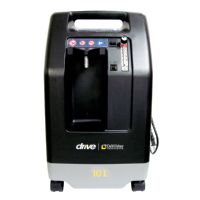 | Drive Medical DeVilbiss 10 LPM Oxygen Concentrator View Product |
Selected as the best compact frame for transport in our review, the Drive Medical DeVilbiss 10 LPM Oxygen Concentrator was built upon the reliable features of their 525 5-liter concentrators. With an identical footprint to the 525 unit and built in the same shell as the 5-liter, this 10 LPM oxygen concentrator from Drive Medical is significantly smaller and lighter in weight than competitive 10-liter concentrators.
Using an outlet pressure of 20 PSI, this concentrator offers 2 to 10 adjustable LPM levels, delivering 87 to 96 percent oxygen purity concentration. The exclusive DeVilbiss OSD (Oxygen Sensing Device) comes with the compressor to ensure it maintains the correct levels of oxygen purity and output for optimal patient safety, along with damage prevention to the unit. Other safety features of the Drive Medical 10 LPM concentrator include alarms that will sound for power outages, flow rates that are too high or too low, high gas temperature, low oxygen concentration, and if service is required. To help guard against damage caused by fire, the cabinet of this concentrator is flame-retardant.
Highlighting bright LED lights that are visible from a distance, the display of the Drive Medical DeVilbiss 10 LPM oxygen concentrator is easy to read, while a knob located on the front of the concentrator enables easy flow adjustments. The flow meter is conveniently located below the knob for verification that the desired setting is selected. A separately-sold humidifier bottle can be added for oxygen humidification. A recessed humidifier nook and a protected cannula port help to prevent accidental damage.
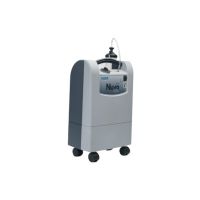 | Nuvo Lite 5 Liter Oxygen Concentrator by Nidek View Product |
Making our review with its super-quiet 40-decibel operation, the Nuvo Lite 5 Liter Oxygen Concentrator by Nidek delivers the best noise level of any other concentrator on our list. Ideal for sleeping, its whisper-quiet operation won’t interfere with conversations, reading, or watching TV. It’s also one of the smallest, most compact home oxygen concentrators, fitting easily under a desk or table. Ruggedly constructed with a durable base and recessed casters to guard against breakage, this popular oxygen concentrator from Nidek Medical also highlights a built-in handle and wheels for easy portability.
Utilizing patented Rapid Pressure Swing Absorption (RPSA) technology, the Nuvo Lite can reach a full oxygen purity concentration of 90 percent (margin of error: +6.5/ -3 percent) at 5 LPM in less than 3 minutes! Offering a customizable therapy range of 12 different liter flow levels between .125 to 5 LPM, this oxygen concentrator provides breathing support in precise doses, using just 330 watts of power.
Its superior-gade molecular sieve beds effectively strip nitrogen from the air, converting it to oxygen. The unique flow rate control comes with a lockable valve so you can lock in your preferred flow rate. Safety features include the automatic shutdown of the compressor if it overheats, along with visual and audible alarms for other malfunctions. The circuit breaker is also conveniently resettable.
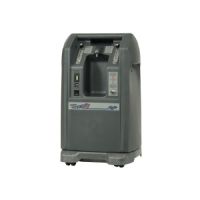 | AirSep New Life Intensity 10-LPM Stationary Oxygen Concentrator by Caire Inc. View Product |
Built to stand up in the busiest of healthcare environments, the AirSep New Life Intensity 10-LPM Stationary Oxygen Concentrator by Caire Inc makes our list as having the best durability for both institutional and at-home care. Robustly designed for repetitive, continuous, 24/7 oxygen supplementation, the AirSep Intensity 10 delivers high-flow oxygen in an adjustable 1 to 10 LPM range to suit multiple users or the changeable requirements of an individual patient.
Offering an oxygen purity concentration of 90 to 92 percent with a generous outlet pressure of 20 PSI, this state-of-the-art oxygen concentrator is ideal for long-term oxygen patients, and can even be used in pediatric applications with a low-flow meter block. Specially designed to work in less-than-ideal conditions, the heavy-duty AirSep Intensity 10 is still safe and completely operational at high altitudes and in environments with up to 95 percent humidity.
With its direct humidifier bottle attachment, the innovative NewLife Intensity 10 enables the administration of humidified oxygen for trach patients and others by connecting a jet nebulizer bottle to the oxygen outlet on the concentrator. Its versatile design facilitates a number of various medical applications, including tracheostomy setup humidification, along with procedures that require large-volume jet nebulizers, medication nebulizers, long oxygen tubing runs, and venturi masks.
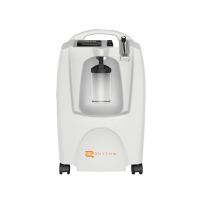 | LM5BA 5L Stationary Oxygen Concentrator by Rhythm Healthcare View Product |
Boasting a proprietary and comprehensive Safety System, the 5 Liter Oxygen Concentrator by Rhythm Healthcare was chosen for our review for offering the best safety features. Synonymous with quality design, doctors and nurses have trusted products from Rhythm Healthcare for decades, and this 5-liter oxygen concentrator is no exception. Compact, durable, and designed for optimal performance, this innovative concentrator can be used for both professional healthcare and at-home applications.
Loaded with a wide variety of safety features to meet every possible scenario and patient need, this oxygen concentrator comes with safety automatic shutdown for power surges, high temperature, high and low pressure, and low oxygen concentration. An alarm will alert users to these issues, along with using heat protection to ensure the safety of the concentrator and compressor.
Reliable, safe, and easy to use, the 5-liter oxygen concentrator delivers oxygen flow rates between 0.5 to 5 LPM at around a 93-percent oxygen purity concentration, ensuring adjustable therapy to meet changing user needs. It offers 5.5 PSI outlet pressure, while its pressure relief mechanism is around 36 PSI to provide optimal flow. Power consumption averages around 360 watts.
Its easy-to-read display makes operation simple, while the smooth-rolling wheels, compact size, and built-in handle facilitate easy placement, storage, and portability.
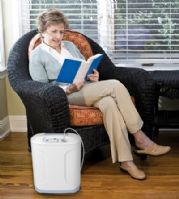 | Inogen At Home Stationary Oxygen Concentrator 5-Liter View Product |
Making our list for its amazing energy efficiency, the Inogen At Home Stationary Oxygen Concentrator 5-Liter uses only 100 watts at a flow setting of 2 LPM - the same energy use as a 100-watt light bulb! Weighing just 18 pounds, this innovative oxygen concentrator from Inogen also boasts the lightest weight and smallest dimensions of any of the devices in our review, making it easy to move to different rooms and to take along with you in a vehicle.
Offering five flow settings from 1 to 5 LPM, this auto-sensing concentrator is perfect for people who have a mild supplemental oxygen prescription. Delivering an oxygen purity concentration range of 87 to 96 percent, the Inogen At Home also offers a higher 19.6 to 40.6 PSIA range of outlet pressure, resulting in highly effective oxygen therapy.
With its simplistic 3-button operation, this oxygen concentrator is easy to use and understand. Maintenance is quick and hassle-free, only requiring a rinse-out of the particle filter once a week. The Inogen At Home is also very quiet, emitting just 40 decibels at a flow setting of 2 which is comparable to the sound level of a desktop computer. Even at higher flow settings, the loudest this concentrator will get is 50 decibels.
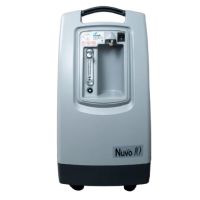 | Nuvo 10 Liter Oxygen Concentrator by Nidek View Product |
As our top choice for the best flow rate, the Nuvo 10 Liter Oxygen Concentrator by Nidek offers unrivaled performance with its 10 LPM (liters per minute) output that uses up to 700 watts of power. Nidek Medical is dedicated to helping patients who need oxygen therapy, delivering top-notch craftsmanship and quality components in a durable design that’s super easy to operate and maintain.
Offering an adjustable flow rate from 2 to 10 liters per minute, the high-efficiency Nuvo 10 comes with several other beneficial design elements to separate it from the competition. Its superior-grade molecular sieve beds produce highly pure oxygen that’s concentrated at 90 percent (degree of error: plus 5 percent, minus 3 percent). Using high outlet pressure of 20 PSI, this oxygen concentrator also highlights a powerful compressor that’s spring-mounted to reduce noise and vibration.
Featuring an intelligent design that’s specifically configured for daily use, the Nuvo 10 is sleek and compact, fitting into most homes and apartments. Yet its heavy-duty frame optimizes durability, making it a great choice for institutional utilization in hospitals, long-term care facilities, and rehab centers. Conveniently wheeled to make placement in other rooms easy to maneuver, its intuitive user panel provides simple and trouble-free operation for oxygen patients of all ages.
Determining the best oxygen concentrator for home use is dependent on a variety of factors, as there are multiple options to choose from to match the unique needs of every individual user. After getting a prescription from your doctor, it is important to consider the oxygen concentrator’s flow rate and capacity, its oxygen concentration and purity range, the safety and ease of its operation, how much power it will consume and its energy efficiency, its noise level, its durability, and how easy it is to move it to different rooms.
Unless you are a medical professional or purchasing for a healthcare operation, yes, a prescription is required to purchase an oxygen concentrator. The FDA has not cleared or approved any oxygen concentrators to be sold or used by regular consumers without a prescription. Taking both too little and too much oxygen can cause serious health problems, so it’s imperative to acquire a prescription from your doctor.
Thankfully, as the technology for oxygen concentrator design has progressed, these devices are much quieter than they used to be. Instead of relying on rubber mounts to absorb the vibrations and noise of the compressor, most oxygen concentrators now use much quieter and more durable spring motor mounts. Some machines also offer a quieter 4-way valve, extra sound-deadening foam, and a different exhaust muffler to keep the operation as quiet as possible. The sound levels for home oxygen concentrators typically range between 31 to 60 decibels, with most offering around 45 decibels, equivalent to average room noise or a quiet conversation.
The maximum flow rate of an oxygen concentrator refers to the most oxygen the device is capable of producing, measured in liters per minute (LPM). Low-flow oxygen concentrators deliver a maximum oxygen flow rate of 5 LPM, while high-flow oxygen concentrators generate a maximum oxygen flow rate of 10 LPM.
Powering a home oxygen concentrator averages about 250 to 600 watts, using less power for 5 LPM (liters per minute) models than 10 LPM models. The cost of running electric oxygen concentrators can vary substantially and is dependent on the needs of the patient, the prescribed flow rate, and local electricity prices.
On average, most oxygen concentrator filters require routine inspection once a week. Depending on the type, you can remove dirt or dust particles with a dry brush. If the filter is excessively dirty, it can usually be washed with warm, soapy water and completely dried before reinstalling into the concentrator. Some oxygen concentrators come with multiple filters that require regular maintenance. Always be sure to reference your concentrator’s user manual to ensure the most accurate care and cleaning tips.
Although oxygen is not flammable, it can cause other nearby materials to more easily ignite and burn much faster. A fire involving oxygen can be explosive, so it is crucial to handle your oxygen concentrator with caution and be aware of potential hazards. Thankfully, oxygen concentrators are one of the safest ways to supply oxygen therapy as very little oxygen is actually stored, unlike oxygen tanks.
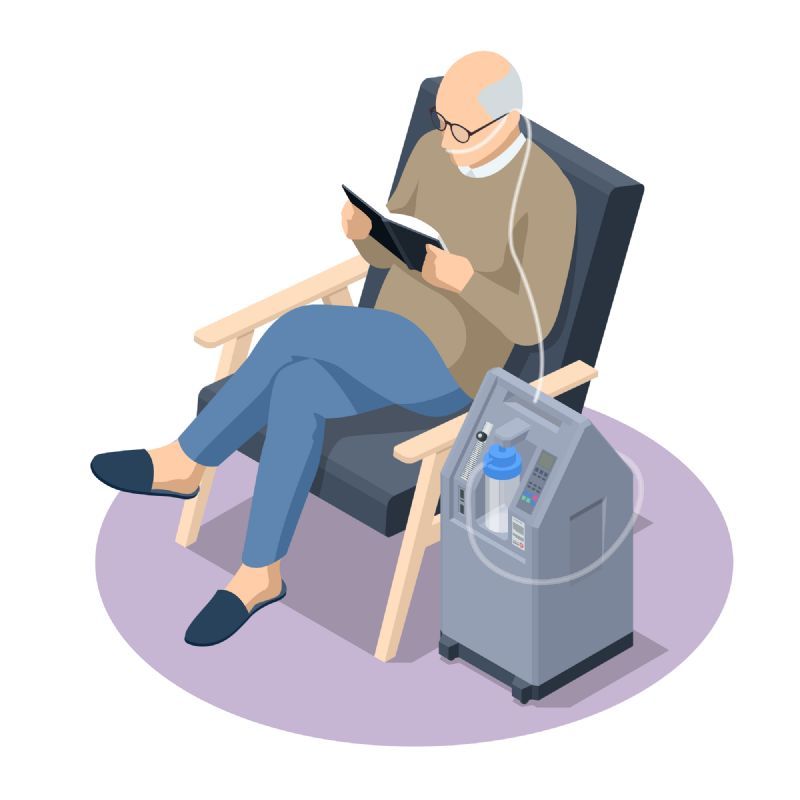
Supplemental oxygen therapy helps people who are living with breathing problems or lung diseases to receive the oxygen their bodies need to function. Your doctor can determine whether you need supplemental oxygen, prescribing the appropriate liter per minute (LPM) of oxygen purity concentration for your particular needs. Providing oxygen at home has many benefits and one of the safest, easiest delivery methods is with an oxygen concentrator for home use.
Also known as stationary oxygen concentrators or oxygen generators, these medical devices collect nitrogen from the ambient room air, converting it to oxygen that’s much more concentrated. Safer than oxygen tanks, and more powerful than portable oxygen concentrators, home oxygen concentrators deliver specific flow rates and concentration levels to meet the variable oxygen supplementation needs and LPM prescription of each patient.
In this article, we covered home oxygen concentrator features to look for, frequently asked questions, and our 6 top picks. Choosing the best oxygen concentrator to meet your needs or the needs of a loved one will depend on multiple factors, including the amount and purity of oxygen your prescription requires, how much power the concentrator uses, and how loud it is during operation. While many of the oxygen concentrators in this review would be a perfect fit for a number of different patients, we gave you the best choices for each different feature.
Thanks so much for taking the time to learn more about oxygen concentrators for home use! We invite you to check out our Caregiver University blog for more information about oxygen therapy, along with a wide variety of other health topics.

Heather Collins, MSN, RN, CNOR
Heather is a registered nurse and freelance health writer with a Master's degree and over 24 years of nursing and leadership experience. Heather cares for patients of all ages in various healthcare settings, including inpatient acute care nursing, GI procedural nursing, cardiac lab, infertility clinics, pediatrics, and surgical services. Heather is dedicated to providing high-quality care and sharing reliable, evidence-based information that empowers people to make informed decisions about their and their loved ones' health.